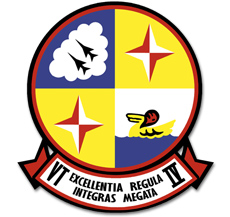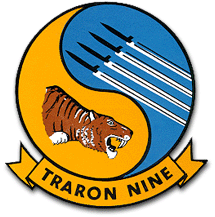
The Grumman S-2 Tracker is the first purpose-built, single airframe anti-submarine warfare (ASW) aircraft to enter service with the United States Navy. Designed and initially built by Grumman, the Tracker was of conventional design — propeller-driven with twin radial engines, a high wing that could be folded for storage on aircraft carriers, and tricycle undercarriage. The type was exported to a number of navies around the world. Introduced in 1952, the Tracker and its E-1 Tracer derivative saw service in the U.S. Navy until the mid-1970s, and its C-1 Trader derivative until the mid-1980s, with a few aircraft remaining in service with other air arms into the 21st century. Argentina is the last country to still operate the Tracker.

The Beechcraft T-34 Mentor is an American propeller-driven, single-engined, military trainer aircraft derived from the Beechcraft Model 35 Bonanza. The earlier versions of the T-34, dating from around the late 1940s to the 1950s, were piston-engined. These were eventually succeeded by the upgraded T-34C Turbo-Mentor, powered by a turboprop engine. The T-34 remains in service more than seven decades after it was first designed.

VT-4 Training Squadron 4 is a training squadron of the United States Navy. Initially established as Basic Training Group 9 (BTG-9) in the 1950s, the squadron was redesignated as Training Squadron 4 (VT-4) on 1 May 1960 and based at Naval Air Station Pensacola, Florida.

Naval Air Station Corpus Christi is a United States Navy naval air base located six miles (10 km) southeast of the central business district (CBD) of Corpus Christi, in Nueces County, Texas.

Naval Air Station Whiting Field is a United States Navy base located near Milton, Florida, with some outlying fields near Navarre, Florida, in south and central Santa Rosa County, and is one of the Navy's two primary pilot training bases. NAS Whiting Field provides training for U.S. Navy, U.S. Marine Corps, Coast Guard, and Air Force student pilots, as well as those of several allied nations. NAS Whiting Field is home to Training Air Wing Five.

A naval aviator is a commissioned officer or warrant officer qualified as a crewed aircraft pilot in the United States Navy or United States Marine Corps. United States Coast Guard crewed aircraft pilots are officially designated as "Coast Guard aviators", although they complete the same undergraduate flight training as Navy and Marine Corps crewed aircraft pilots, and are awarded the same aviation breast insignia.

The VT-9 Tigers is one of four U.S. Navy strike jet training squadrons and one of two based at Naval Air Station Meridian in Mississippi.

Training Squadron TEN (VT-10) is a training squadron of the United States Navy. The squadron is homebased at NAS Pensacola, Florida.

Training Squadron EIGHT SIX (VT-86), also known as the "Sabrehawks," is a United States Navy advanced jet training squadron based at the Naval Air Station Pensacola, Florida. Training Squadron 86 is a tenant command of Training Air Wing 6. They are a training squadron flying the T-45C Goshawk. Their tailcode is F and their radio callsign is ROKT.

Naval Air Station Kingsville or NAS Kingsville (NASK) is a United States Navy Naval Air Station located approximately 3 miles east of Kingsville, Texas in Kleberg County. NAS Kingsville is under the jurisdiction of Navy Region Southeast and is the headquarters of Training Air Wing Two. The station also operates a nearby satellite airfield, NALF Orange Grove.

Training Squadron Six (VT-6) or TRARON SIX, known as the Shooters, callsign "Shooter", is a United States Navy primary training squadron stationed at Naval Air Station Whiting Field flying the T-6B Texan. The Shooters are one of five primary training squadrons in operation today.
Acadiana Regional Airport is a public use airport in Iberia Parish, Louisiana, United States. It is owned by Iberia Parish, managed by the Iberia Parish Airport Authority and is located four nautical miles (7 km) northwest of the central business district of New Iberia, Louisiana near U.S. 90.

The Naval Air Training Command (NATRACOM) is a one-star Echelon III command that conducts flight training of student Naval Aviators, and Naval Flight Officers. Though it does not conduct Naval Aircrew training which is conducted by Naval Education and Training Command's Naval Aviation Schools Command (NASC), it is responsible for monitoring the production of Aircrewmen through the Naval Aviator Production Process (NAPP). Through the NAPP, NATRACOM is also responsible for programming and monitoring the production of all Navy and Marine Corps Fleet Replacement Squadrons.
Naval Air Station New Iberia, located near New Iberia, Louisiana, was a short-lived training facility of the United States Navy which operated for a mere five years in the 1960s. The naval base at New Iberia was actually designated NAAS, indicating that it was a Naval Auxiliary Air Station. The U.S. Navy airfield identifier for New Iberia was KNIL.

The VT-28 "Rangers" is a U.S. Navy primary flight training squadron based at Naval Air Station Corpus Christi, Texas.

Training Squadron 22 (VT-22) or TRARON TWO TWO, known as the Golden Eagles, callsign "Blazer", is a U.S. Navy strike jet training squadron stationed aboard Naval Air Station Kingsville, flying the T-45C Goshawk. The Golden Eagles are one of four strike jet training squadrons in operation today, and are under the command of Training Air Wing Two.

Training Squadron 21 (VT-21), known as the Redhawks, is a U.S. Navy strike jet training squadron stationed aboard Naval Air Station Kingsville, Texas flying the T-45C Goshawk. The Redhawks are one of four strike jet training squadrons in operation today, and are under the command of Training Air Wing Two.

Training Air Wing ONE is a United States Navy aircraft training air wing based aboard Naval Air Station Meridian, located 11 miles northeast of Meridian, Mississippi in Lauderdale County and Kemper County. TW-1 is one of five training air wings in the Naval Air Training Command, and consists of two jet training squadrons. The wing trains Student Naval Aviators from the U.S. Navy, U.S. Marine Corps, and international allies. Following completion of primary flight training and selection of an advanced training pipeline, Student Naval Aviators are assigned to TW-1 for either intermediate and advanced strike pipeline training or advanced E-2/C-2 training in the T-45C Goshawk jet training aircraft.

Training Squadron SEVEN (VT-7), known as the Eagles, is one of four U.S. Navy strike jet training squadrons and one of two based at Naval Air Station (NAS) Meridian. VT-7, along with Training Squadron NINE (VT-9), make up Training Air Wing One of the Naval Air Training Command. In addition to providing advanced training for strike jets, VT-7 provides additional advanced training for airborne early warning and carrier onboard delivery aircraft. VT-7 also trains United States Marine Corps (USMC) aviators and select foreign military pilots.
Naval Outlying Landing Field Waldron or Waldron Field is a military airport in Corpus Christi, Texas. Owned and operated by the United States Navy, Waldron Field served as satellite field to support flight training in Naval Air Station Corpus Christi.


















